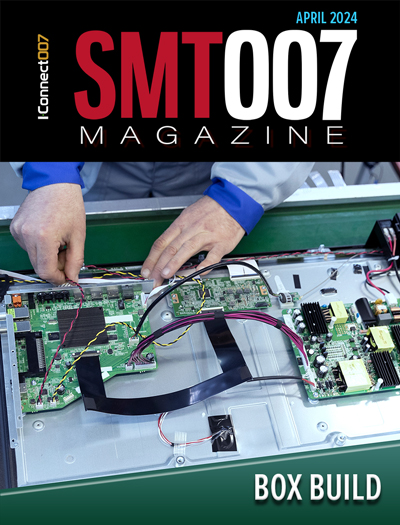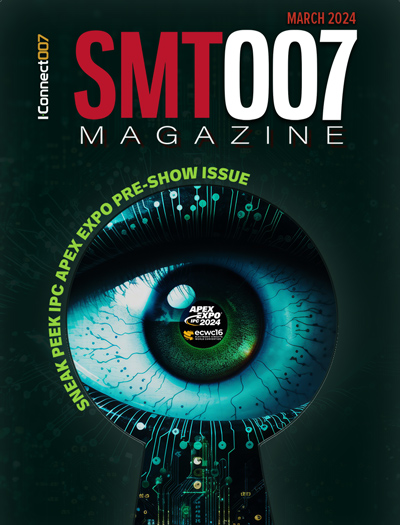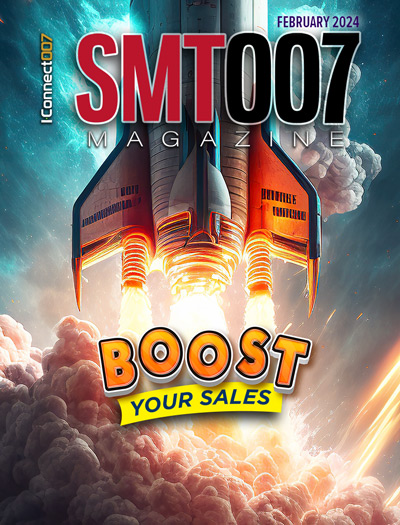-

- News
- Books
Featured Books
- smt007 Magazine
Latest Issues
Current Issue
Box Build
One trend is to add box build and final assembly to your product offering. In this issue, we explore the opportunities and risks of adding system assembly to your service portfolio.

IPC APEX EXPO 2024 Pre-show
This month’s issue devotes its pages to a comprehensive preview of the IPC APEX EXPO 2024 event. Whether your role is technical or business, if you're new-to-the-industry or seasoned veteran, you'll find value throughout this program.

Boost Your Sales
Every part of your business can be evaluated as a process, including your sales funnel. Optimizing your selling process requires a coordinated effort between marketing and sales. In this issue, industry experts in marketing and sales offer their best advice on how to boost your sales efforts.
- Articles
- Columns
Search Console
- Links
- Events
||| MENU - smt007 Magazine
Partnership and Collaboration
June 28, 2022 | I-Connect007 Editorial TeamEstimated reading time: 2 minutes
Dan Beaulieu and Nolan Johnson recently had a conversation with Christopher Kalmus of Aurora Circuits and Brigitte Lawrence of Brigitflex. Joining them was Jeff Brandman of Aismalibar North America. The group discussed the value of partnerships, noting how it has helped them win and keep business. They also describe a recent project for an OEM manufacturer in the automotive industry that served as a case study for this discussion.
Nolan Johnson: What does partnership mean in your working relationship?
Christopher Kalmus: It means working together, trying to solve a problem that’s of value to all of us.
Brigitte Lawrence: When a customer comes to us, needs something produced, and we don’t have everything at our fingertips, we can work together with others to help the customer. We can work together to accomplish it in the timeframe, money frame, and everything else to get it out to the assembler or our customer.
Johnson: Is this a tactical or a strategic kind of relationship?
Lawrence: Neither. It’s a friendship. In this type of situation, we’re not competing. We are working together underneath an umbrella to keep everything friendly and competitive free. We each have our own niche, we know where it’s at, and we don’t cross each other.
Johnson: So, by having complementary areas of specialty, you can work together, making those component pieces larger than the individual parts?
Lawrence: It’s larger than the industry when we put it together.
Dan Beaulieu: The way I see it, you have some operations that Chris can’t do, and he has some that you can’t do.
Kalmus: That’s right Dan. These are unusual times. We’re dealing with an industry that’s basically been devastated over the last two decades. You go back three decades, and the U.S./North America produced maybe 50–60% of all the circuit boards in the world. It was a highly resilient industry; it could take some body blows and still be okay. I’ve seen a lot of different estimates that we now produce probably less than 4% of the world’s production, while China currently is probably producing more than 50%.
Beaulieu: Some sources say over 80%.
Kalmus: Our industry is so stretched that it’s not even possible for everybody to have everything that they want, to do everything that they want. Partnerships, from materials to final assembly, help fill the void.
Lawrence: We must work together. We must trust each other. We must use each other’s machinery. Sometimes we are not allowed to collaborate, but we do it when we can. We do what we can to keep things here and work together as a team, keeping things here in the States. It’s not just building the product. It’s keeping the machinery running and keeping our factories running. It’s what it takes to build the product.
Kalmus: Circuit board innovations have always relied on people who have ideas, who know how to do things, and can extrapolate to other ways of doing things. To me, that’s probably the bigger part of our partnership. Brigitte and Chuck (Lawrence) are two unique people in the printed circuit board world, with their knowledge and what they’re capable of doing. We’ve always been innovative, going all the way back to Kalmus and Associates in the 1950s and 1960s.
To read this entire conversation, which appeared in the June 2022 issue of SMT007 Magazine, click here.
Suggested Items
Lockheed Martin Australia, The Department Of Defence Sign Strategic Partnership Head Contract
04/26/2024 | Lockheed MartinLockheed Martin Australia signed a landmark AUD$500 million contract with the Department of Defence to build Australia’s future Joint Air Battle Management System under project - AIR6500 Phase 1 (AIR6500-1).
SMC Korea 2024 to Highlight Semiconductor Materials Trends and Innovations on Industry’s Path to $1 Trillion
04/24/2024 | SEMIWith Korea a major consumer of semiconductor materials and advanced materials a key driver of innovation on the industry’s path to $1 trillion, industry leaders and experts will gather at SMC (Strategic Materials Conference) Korea 2024 on May 29 at the Suwon Convention Center in Gyeonggi-do, South Korea to provide insights into the latest materials developments and trends. Registration is open.
Elevating PCB Design Engineering With IPC Programs
04/24/2024 | Cory Blaylock, IPCIn a monumental stride for the electronics manufacturing industry, IPC has successfully championed the recognition of the PCB Design Engineer as an official occupation by the U.S. Department of Labor (DOL). This pivotal achievement not only underscores the critical role of PCB design engineers within the technology landscape, but also marks the beginning of a transformative journey toward nurturing a robust, skilled workforce ready to propel our industry into the future.
Real Time with... IPC APEX EXPO 2024: Going Vertical: SCHMID's Advanced Solutions for Printed Circuit Boards
04/24/2024 | Real Time with...IPC APEX EXPOEditor Marcy LaRont chats with Bob Ferguson, the president of SCHMID, about advanced solutions for PCBs and the equipment they are highlighting at this year's show. He delves into vertical no-touch handling systems and the prospect of achieving sub-10-micron lines. Inspired by SCHMID's technology, Bob expresses excitement about where the industry is today.
Big Win for Defense Production Act Budget Allocation in FY24 Budget
04/23/2024 | I-Connect007 Editorial TeamOne year ago, President Biden issued a determination that chips and packaging are critical for national security. Since that time, much work has been done to continue the conversation in Washington, elevating the importance of the entire chips value chain, and including printed circuit boards and substrates, without which chips cannot operate.


